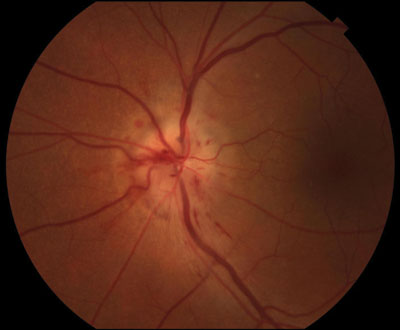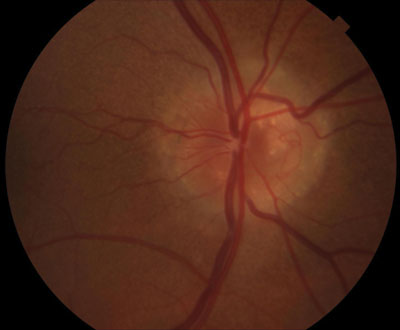Man presents with unilateral loss of vision and headaches
On examination, unilateral disc edema and contralateral disc pallor were seen.
 Priti Batta |
 Namrata Nandakumar |
A 58-year-old man presented to our eye clinic with a complaint of slowly progressive loss of vision in the left eye for 1 week, associated with bitemporal headaches. He denied any fevers, jaw claudication, myalgias, weight loss, fatigue or decreased appetite.
He did not have any significant ocular, medical or family history, although he admitted that he had not seen a physician for more than 20 years. He was not taking any ocular or systemic medications.
On examination, the patient’s best corrected visual acuity was 20/25 in the right eye and count fingers at 8 feet in the left eye, with no improvement on pinhole refraction. A relative afferent pupillary defect was present in the left eye. IOP by applanation was 17 mm Hg in the right eye and 18 mm Hg in the left eye. On confrontation visual field testing, an inferior hemifield defect was found in the left eye. External examination was notable for a prominent right superficial temporal artery that was non-tender to palpation.
Anterior segment examination of both eyes was unremarkable except for mild nuclear sclerotic cataracts. Posterior segment examination revealed 360° of blurred disc margins in the left optic nerve head, associated with peripapillary flame and splinter hemorrhages (Figure 1). The right optic nerve head had nasal pallor but no disc swelling or hemorrhage (Figure 2). Both optic nerve heads also had small cups. The retina appeared normal in both eyes.
 Figure 1. Optic disc photo of the left eye showing disc edema and peripapillary hemorrhages. Images: Bhavsar K, Hedges TR
|
 Figure 2. Optic disc photo of the right eye showing nasal pallor. |

What is your diagnosis?
Unilateral disc edema, contralateral optic atrophy
The differential diagnosis for unilateral disc edema and contralateral optic atrophy includes Foster Kennedy syndrome, pseudo-Foster Kennedy syndrome, and an infiltrative optic nerve lesion due to inflammatory or infectious conditions.
Foster Kennedy syndrome presents with unilateral disc edema and contralateral optic atrophy, secondary to a compressive optic nerve lesion. A large mass lesion may compress one optic nerve, resulting in atrophy, while indirectly inducing contralateral optic disc edema from elevated intracranial pressure. Lesions known to produce this clinical picture include meningiomas and other large frontal lobe tumors or tumors arising from the olfactory groove.
The term pseudo-Foster Kennedy syndrome refers to a clinical presentation identical to Foster-Kennedy syndrome, namely optic disc edema in association with contralateral optic atrophy. However, the cause in this case is not a compressive lesion, but rather an ischemic optic neuropathy with sequential involvement of both nerves. Both nonarteritic and arteritic anterior ischemic optic neuropathy can cause pseudo-Foster Kennedy syndrome, although the nonarteritic form is more common. Arteritic anterior ischemic optic neuropathy (AAION), due to giant cell arteritis, typically occurs in elderly patients who are 60 to 70 years of age. Patients may complain of systemic symptoms, including jaw claudication and scalp tenderness, particularly over the superficial temporal arteries. There may be rapid progression with bilateral optic nerve involvement, and a central retinal artery occlusion can occur. Nonarteritic anterior ischemic optic neuropathy (NAION) occurs in younger patients, typically between 40 to 60 years of age. It may cause segmental or diffuse disc edema, with most patients experiencing symptoms upon awakening in the morning.
Infiltrative lesions of the optic nerve may also give a similar presentation. Both infectious and noninfectious etiologies may be considered in the differential diagnosis. Optic neuritis and resultant optic atrophy may be seen with syphilitic disease. Sarcoidosis causes granulomatous inflammation of the optic nerve and other ocular complications, including choroidal granuloma, macular edema and intermediate uveitis.
Diagnosis and management
Given the rapid visual deterioration, the finding of a prominent superficial temporal artery and the age of the patient, it was essential to investigate AAION vs. NAION as a potential etiology for this patient’s presentation. Erythrocyte sedimentation rate (ESR) and non-cardiac C-reactive protein (CRP) levels were obtained in the emergency room and found to be 51 and 46, respectively. CT scan of the head ordered by the emergency department physician was found to be unremarkable. Empiric therapy with oral prednisone 60 mg was initiated, given concern for AAION.
Visual field testing (HVF 30-2) was performed in the clinic. The field from the left eye depicted dense superior and inferior altitudinal defects. The field from the right eye showed superonasal and inferior arcuate scotomas. Optical coherence tomography scan revealed thinning of the retinal nerve fiber layer (RNFL) at 73 µm in the right eye and disc edema with RNFL thickness measurement of 177 µm in the left eye. A left temporal artery biopsy was scheduled within 2 days of initial presentation; the results were consistent with intimal thickening and calcification of the elastic lamina and media with no evidence of vasculitis.
Due to the negative temporal artery biopsy, the patient was diagnosed with NAION. A slow steroid taper was completed, and aspirin therapy was initiated. Follow-up was arranged with a primary care physician for general medical evaluation. At future ophthalmologic visits, repeat ESR/CRP, HVF and OCT will be obtained for further monitoring.
Discussion
The majority of cases of anterior ischemic optic neuropathy are nonarteritic. NAION typically affects those aged 40 to 60 years, whereas AAION is rarely seen in individuals aged younger than 60 years. The pathophysiologic process behind NAION is presumed to be inadequate perfusion of the optic nerve head. Ocular associations include the so-called “disc at risk” or hyperopic-appearing disc with small cup. The mechanical constraint of a small cup is theorized to perpetuate ischemia of the nerve fiber layer through a compartment-like syndrome. Systemic conditions that may predispose an individual to NAION include atherosclerosis, obstructive sleep apnea and medications. The association between sleep apnea and NAION may be explained through several mechanisms, including episodic nocturnal hypotension, repetitive prolonged hypoxia and elevated intracranial pressure. Further, amiodarone and sildenafil have both been implicated as potential risk factors in the development of NAION.
The natural history of the disease is characterized by some potential for visual improvement; approximately 40% of patients experience some improvement in their visual acuity and 26% in visual field testing. Recurrence rate in the affected eye is approximately 6%.
It is important to note that there is no firmly established treatment of NAION. Typically, systemic risk factors are sought and targeted. Timing and dosing of blood pressure medications are changed to prevent nocturnal hypotension. Aspirin therapy may be initiated, especially if there are other systemic indications, including cardiovascular disease. The use of brimonidine for its neuroprotective effects has been considered by some ophthalmologists, as well as the controversial use of steroid therapy. Optic nerve sheath decompression has largely fallen out of favor because it may be harmful. Some case series have described the use of intravitreal Avastin (bevacizumab, Genentech) to facilitate recovery from potentially VEGF-mediated vasogenic optic disc edema and concurrent macular edema.
References:
- Bernstein SL, Guo Y, Kelman SE, Flower RW, Johnson MA. Functional and cellular responses in a novel rodent model of anterior ischemic optic neuropathy. Invest Ophthalmol Vis Sci. 2003;44(10):4153-4162.
- Deramo VA, Sergott RC, Augsburger JJ, Foroozan R, Savino PJ, Leone A. Ischemic optic neuropathy as the first manifestation of elevated cholesterol levels in young patients. Ophthalmology. 2003;110(5):1041-1046.
- Hayreh SS. Anterior ischaemic optic neuropathy. I. Terminology and pathogenesis. Br J Ophthalmol. 1974;58(12):955-963.
- Hayreh SS. Anterior ischaemic optic neuropathy. II. Fundus on ophthalmoscopy and fluorescein angiography. Br J Ophthalmol. 1974;58(12):964-980.
- Hayreh SS. Anterior ischaemic optic neuropathy. III. Treatment, prophylaxis, and differential diagnosis. Br J Ophthalmol. 1974;58(12):981-989.
- Hayreh SS. The role of aspirin in non-arteritic anterior ischaemic optic neuropathy. Neuro-Ophthalmology. 2010;34(1):1-5.
- Hayreh SS, Zimmerman MB. Incipient nonarteritic anterior ischemic optic neuropathy. Ophthalmology. 2007;114(9):1763-1772.
- Hayreh SS, Zimmerman MB. Non-arteritic anterior ischemic optic neuropathy: role of systemic corticosteroid therapy. Graefes Arch Clin Exp Ophthalmol. 2008;246(7):1029-1046.
- Landau K, Winterkorn JM, Mailloux LU, Vetter W, Napolitano B. 24-hour blood pressure monitoring in patients with AION. Arch Ophthalmol. 1996;114(5):570-575.
- Mojon DS, Hedges TR 3rd, Ehrenberg B, et al. Association between sleep apnea syndrome and nonarteritic anterior ischemic optic neuropathy. Arch Ophthalmol. 2002;120(5):601-605.
- Pomeranz HD, Bhavsar AR. Nonarteritic ischemic optic neuropathy developing soon after use of sildenafil (Viagra): a report of seven new cases. J Neuroophthalmol. 2005;25(1):9-13.
- Kavita Bhavsar, MD, and Thomas R. Hedges III, MD, can be reached at New England Eye Center, Tufts University School of Medicine, 750 Washington St., Box 450, Boston, MA 02111; 617-636-4219; fax: 617-636-4866; website: www.neec.com.
- Edited by Priti Batta, MD, and Namrata Nandakumar, MD. Drs. Batta and Nandakumar can be reached at New England Eye Center, Tufts University School of Medicine, 750 Washington St., Box 450, Boston, MA 02111; 617-636-4219; fax: 617-636-4866; website: www.neec.com.

